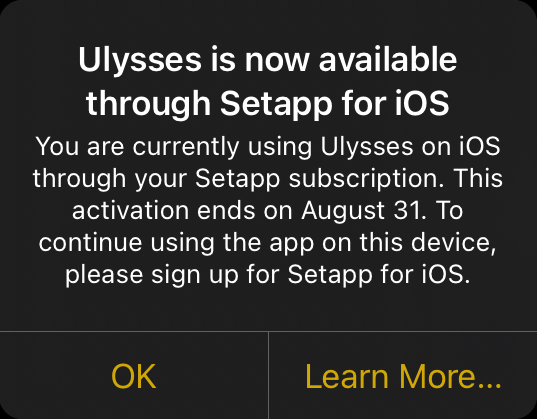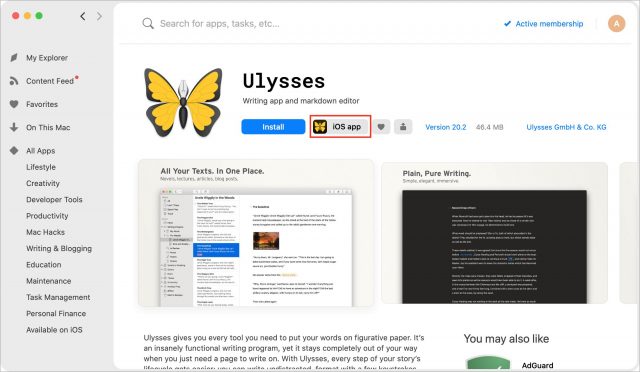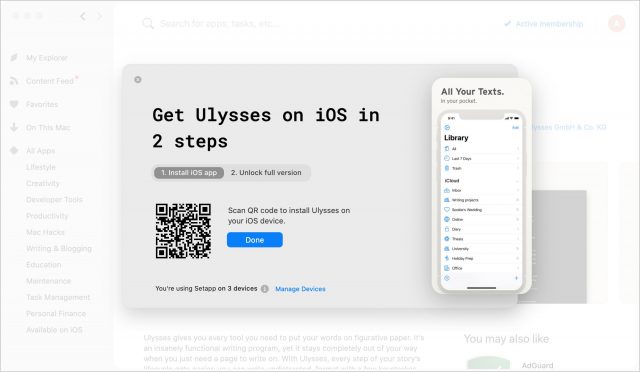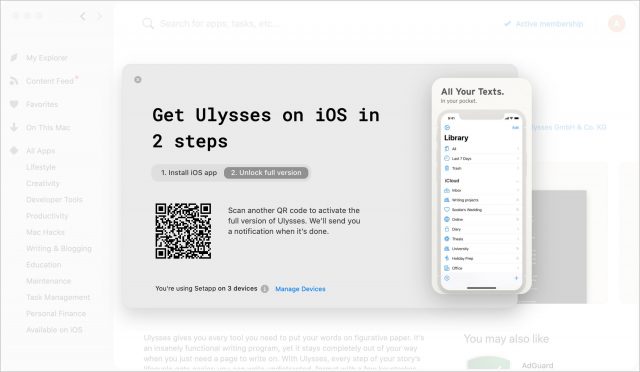Setapp Subscription Service Adds iOS Companion Apps
Since 2017, the Setapp service has been providing subscribers with access to an ever-increasing number of Mac apps for a single $9.99-per-month fee, with options for families and businesses. See our full Setapp coverage for details.
By my count, Setapp is now up to 193 Mac apps, but the big news that the company just announced is that it is adding iOS apps to the service. At the moment, eight apps are available: the iOS versions of Mac apps 2Do, Gemini, MindNode, Paste, PDF Search, SQLPro Studio, Taskheat, and Ulysses.
In conjunction with the addition of iOS apps, Setapp has switched to a per-device subscription approach. The main subscription remains $9.99 per month, but to use the iOS apps, new users have to add another device for an additional monthly. Previously, you could use Setapp on a second Mac just by signing in, and it appears that existing users now have two devices available, one of which could be used for an iOS device. iOS apps aren’t yet available for those with Family plans, but Setapp is working on it.
At the launch last week, Setapp priced additional devices at $4.99 per month, but after users complained, the company dropped the price. Setapp PR manager Julia Petryck said:
As a result of feedback from the Setapp community, today we’re changing the price for additional devices for all Setapp plans to make it more affordable to start using iOS devices with a Setapp subscription. The price for each additional device has been decreased from $4.99 to $2.49.
Kudos to Setapp for responding to its users so promptly. Since enabling both an iPhone and an iPad would require two device subscriptions, $4.99 for each of them seemed expensive, whereas $2.49 per device feels more reasonable.
As with Setapp’s Mac apps, the amount you’d save by subscribing through Setapp rather than paying or subscribing through the App Store varies, but Ulysses alone has a $5.99 per month subscription cost through the App Store. That said, before this change, the iOS versions of Ulysses and a few other apps were free for Setapp users—our security editor, Rich Mogull, found that his previously free activation of Ulysses ends at the end of the month. So this change is good for developers but may be more expensive for users who use only one or two iOS apps.
Adding an iOS App to Setapp
Assuming you have a free device slot available, registering an iOS app via Setapp is easy, if somewhat unusual. You start by launching Setapp on a Mac and navigating to the app you want to install.
Once there, click the iOS App button, which presents a dialog with a QR code to scan using the Camera app on your iPhone or iPad.
Scanning that QR code simply loads the App Store page for the app, from which you can download the standard app from the App Store—there’s no special version in play here. All the iOS apps in Setapp are free to download with in-app purchases.
The magic occurs in the next step, where you click Done or move the slider to “2. Unlock full version.” That reveals another QR code that, when scanned, opens the downloaded app and registers it (and your device, on the first usage) into your Setapp account. From then on, the app works just as though you had purchased a normal subscription.
I’ve confirmed that the process works as documented.
How Is This Acceptable to Apple?
You’d be forgiven if this sounds like an end-run around Apple’s 30% fee, and indeed, Apple’s App Store Review Guidelines state:
3.1.1 In-App Purchase: If you want to unlock features or functionality within your app, (by way of example: subscriptions, in-game currencies, game levels, access to premium content, or unlocking a full version), you must use in-app purchase. Apps may not use their own mechanisms to unlock content or functionality, such as license keys, augmented reality markers, QR codes, etc. Apps and their metadata may not include buttons, external links, or other calls to action that direct customers to purchasing mechanisms other than in-app purchase.
However, Setapp is adamant that its approach is legit, responding to a question on Twitter with:
We would never put our vendors at risk. Therefore we’ve received approval from Apple before going forward. It was confirmed that applications with integrated Setapp iOS framework fulfill the App Store Guidelines.
Indeed, since all the iOS apps in question also work on the Mac, they would seem to fall under this exception:
3.1.3(b) Multiplatform Services: Apps that operate across multiple platforms may allow users to access content, subscriptions, or features they have acquired in your app on other platforms or your web site, including consumable items in multiplatform games, provided those items are also available as in-app purchases within the app. You must not directly or indirectly target iOS users to use a purchasing method other than in-app purchase, and your general communications about other purchasing methods must not discourage use of in-app purchase.
Of course, Apple remains the ultimate arbiter of how that paragraph will be interpreted. One point of concern—the fact that the purchase is mediated through Setapp—would seem to be addressed by Setapp’s statement that apps that integrate the Setapp iOS framework fulfill App Store guidelines. Another hitch could be the requirement that “those items are also available as in-app purchases within the app.” It’s hard to know how the Setapp approach of compensating developers with a proportion of subscription fees based on app usage would translate to a comparable in-app purchase.
When I asked if Setapp planned to add any iOS-only apps or if the only iOS apps would be companions to Mac apps, Julia Petryk’s response suggested, albeit a bit ambiguously, that iOS-only apps might be in Setapp’s future: “Yes, iOS apps will go through the review process by the Setapp review team and in case of their approval, they will join Setapp.”
Given Apple’s explicit prohibition—Apps may not use their own mechanisms to unlock content or functionality, such as license keys, augmented reality markers, QR codes, etc.—it’s hard to imagine that Apple will allow Setapp to provide access to iOS-only apps. But if there’s one thing we’ve learned with the App Store, it’s that Apple reserves the right to interpret or change the rules as it wants.
For now, though, we’ll give Setapp points for pushing the boundaries of what’s possible in the iOS world and providing a service that at least some subscribers will appreciate. Whether it’s worthwhile remains a personal question based on how many of the iOS apps you would use and how many devices you need to add. Still, I have to say that we enjoy having access to the Setapp library of Mac apps on an ongoing basis.




The idea that you have to pay for each iOS device seems completely antithetical to the way that app purchases have worked for the longest time.
Except for Things, most apps have one price for iPhone and iPad.
The net result of this decision for me was to decide that I really don’t use/need Ulysses enough to justify paying another $10/month for Setapp on iOS, and their iOS offerings are extremely weak right now (it’s basically Ulysses and a few other apps that you may never have even heard of).
Setapp has responded to complaints from users along these lines and dropped the per-device price. Julia Petryck told me:
That seems much more reasonable.
I’ve updated the article to reflect this change.
As of September 1st, if all I’m using Ulysses, and I want to use it on September 1st on my Mac, iPhone, and iPad, then the price went from $10/month to $15/month instead of $20/month.
That’s better… but it’s still a 50% increase for the same thing I was paying for on August 31st instead of a 100% increase.
Yep. Setapp only makes sense if you use enough of the apps in it. If all you’re using is Ulysses, it’s a price hike no matter what. Their goal is to add more iOS apps so that it becomes worthwhile again.
Yeah, thankfully they sensibly dropped the price from $5 to $2.5. Otherwise it would not appeal to most I suspect, given interested users typically own a phone and pad. And also iOS apps are typically much less feature packed as mac ones, so this makes much more sense, price wise.
Along with two Macs, I have two pads and a phone, so 15 -> 7.5 is more likely to get me to consider. But for the moment they’ll have to expand the offering to get me to bite. So we’ll have to wait and see.
Should add…
One wonders if Apple can smell the coffee here, and just as they did for music, realise that they’ll sooner or later have to offer an app subscription model of some kind. Given the Apple Silicon transition, surely this seems inevitable.
The only problem is that given the sheer volume of utility apps currently available on iOS/iPadOS (along with their macOS counterparts), where would they begin to draw a select group, that would make is financially viable? Also, it could introduce a two-tiered system of ‘preferred’ vs ‘secondary’ apps, or suchlike.
The only thing that dev companies would likely have going for joining such an offering, is a larger target audience coming straight from Apple, rather than from this separate Setapp company, and potential regular decent financial returns from doing so.
What with the current Epic store issue (for Google too), some flux may be incoming in app-land.
General purpose software is different from media.
Music and video pretty much all cost the same. Music sells for about $1 per track (some a little more, some a little less), albums sell for about $10 to download or $15-20 on CD. Movies all rent for $2-5, sell for under $20 to download and or under $30 on disc.
Even gaming software is similar, with most new titles selling for $50-60 and older titles being discounted.
In general, if all products sell for about the same price, then you can make a subscription model work. You figure out how many titles a person is likely to use in a month, determine the pro-rated cost (vs if they were purchased) and compute a monthly fee.
But general purpose software is different. You’ve got prices that range from under $10 up to thousands of dollars. Microsoft Office costs a lot less than Adobe Creative Cloud, for instance. Any subscription offering is either going to be forced to omit high-end titles or charge a high price in order to include these titles.
Setapp can only work because they don’t support applications that sell/rent with high price tags.
Yeah agree, you’re never gonna get your MS or Adobe-level software on it. But that’s pretty much mostly what Setapp offer now – low-to-mid tier apps. So Apple would likely go down that route as well, I suspect.
Do I have this correct…
Didn’t your first $10/mth (or the annual sub) get you TWO Macs?
Are current customers still getting that or are they now halving our usage down to just ONE Mac??
If so, that’s not on: I’ve paid an annual sub for TWO Macs, so that’s what I should be getting, and is a straight forward breach of contract!
(If they are halving it down to one Mac then it should be for new customers only, not those on legacy contracts or upgrading.)
They’re not clear at all on their website on this. :-/
It’s tricky, but what I think is the case is that existing subscribers got two devices when they moved to the per-device subscription plan because previously Setapp allowed you to install on at least two Macs. @rmogull told me he had a normal pre-existing subscription and ended up with two devices. (My subscription is weird because it’s press and teams, so I have five devices.) I supposed it’s conceivable that you only get two devices if you had actually used two before.
With the move to the per-device approach, I believe new subscribers get only one device.
You’d want to check with Setapp customer support if you’re not seeing two devices on an existing plan.
Thanks, yes that possibly makes sense. Unfortunately, I don’t have 2016 MBP15 with me at the moment, so can’t check it for a while. So will have to see later on.
So effectively…
• New customers:
10/mth: 1 Mac.
+2.50/mth: +1 Mac/iOS/iPadOS.
= 12.50: 2 devices.
• Legacy customers:
10/mth: 2 Macs.
+2.50/mth: +1 Mac/iOS/iPadOS.
= 12.50: 3 devices.
…I hope!